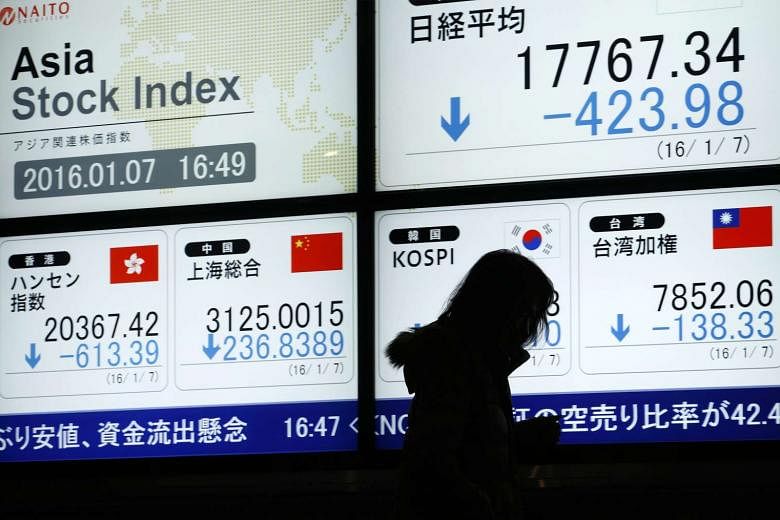WELLINGTON/TOKYO (REUTERS, BLOOMBERG) - China's efforts to restore calm to its turbulent markets showed early signs of success as the yuan stabilized and regional equities rallied for the first time in five days. US treasuries and the yen fell as demand for havens eased.
The Shanghai Composite Index gained 2.4 per cent at the midday break after the securities regulator suspended a controversial circuit-breaker system, while Asia's benchmark share index pared its biggest weekly drop since 2011. The yuan rose 0.1 per cent in onshore trading after the central bank ended an eight-day stretch of setting weaker reference rates.
Chinese state-controlled funds also stepped in to buy equities for at least the second time this week, according to people familiar with the matter. Funds purchased financial shares and others with large weightings in benchmark indexes, the people said.
Singapore's Straits Times Index reversed an opening drop of more than 1 per cent to trade 0.79 per cent higher at 2,751.41 as at 1:14 am.
Japan's Topix index gained 0.3 per cent, reversing an earlier loss of as much as 1.2 per cent. Australia's S&P/ASX 200 Index slid 0.4 per cent while South Korea's Kospi index was up 0.6 per cent. The Hang Seng Index rose 1.1 per cent.
Global shares have lost more than US$4 trillion this year as renewed volatility in Chinese markets revived concerns over the ruling Communist Party's ability to manage the world's second- largest economy. The tumult has heightened worries over competitive devaluations and disinflation as emerging-market currencies tumbled with commodities. Investors will shift their attention to America's economy on Friday as the government reports monthly payroll figures, a key variable for US interest rates.
China abandoned its circuit breaker after analysts blamed the new mechanism for exacerbating declines in share prices this week. Mainland exchanges shut early on Thursday and Monday after plunges of 7 per cent in the CSI 300 triggered automatic halts.
The People's Bank of China set the yuan's daily fixing, which restricts onshore moves to a maximum 2 per cent on either side, at 6.5636 per dollar, or 0.02 per cent stronger than Thursday's rate. That's 0.5 per cent higher than Thursday's onshore effective closing price in the spot market and ends an eight-day reduction of 1.42 per cent.
The onshore yuan recovered to 6.5874 at around 0500 GMT, while the offshore yuan was about 1.4 per cent weaker at 6.6835, narrowing a spread that reached around 2 per cent a day earlier.
Since the PBOC devalued the yuan by about 2 per cent last August, the spread has been growing, encouraging an outflow of capital that Beijing has been trying to stem.
"While the market was left with uncertainty on how far the yuan will fall, the Chinese central bank's action (the stronger fix on Friday) was taken as a signal that it does not intend to keep allowing the yuan to fall," said Yoshinori Shigemi, a market strategist at JPMorgan Asset Management.
Sources told Reuters that China's foreign exchange regulator has ordered banks in some trading hubs, including Shenzhen, to limit clients' dollar purchases this month, the latest attempt to stem capital outflows.
Standard Chartered and DBS Group Holdings are among three lenders that China's central bank last week suspended from conducting some foreign exchange business, three sources with direct knowledge told Reuters on Thursday.
Sources for an earlier story on cross-border currency dealing said some banks may have been targetted because of the large scale of their cross-border forex businesses.

